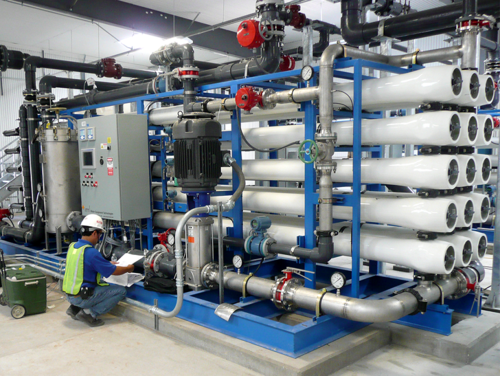Your Overview to PFAS Treatment Technologies and Advantages
The frequency of PFAS contamination in water resources demands an extensive understanding of offered therapy innovations. Different techniques, such as turned on carbon purification, ion exchange systems, and progressed oxidation procedures, existing unique benefits in dealing with these consistent contaminants. Each technology not just targets certain PFAS compounds but also plays an important duty in improving total water high quality and securing ecological integrity. As areas come to grips with the ramifications of PFAS direct exposure, the selection of an ideal treatment strategy ends up being significantly essential, motivating a more detailed examination of these modern technologies and their corresponding advantages.
Understanding PFAS Contamination
Understanding PFAS contamination is essential for resolving its pervasive influence on environmental and human wellness (m270 pfas treatment). Per- and polyfluoroalkyl materials (PFAS) are a team of synthetic chemicals extensively utilized in various commercial and customer products because of their water- and grease-resistant residential properties. Commonly discovered in firefighting foams, non-stick cooking equipment, and water-repellent textiles, PFAS have actually gotten in the atmosphere through production processes, wastewater discharges, and seeping from garbage dumps
When released, these compounds continue the atmosphere, causing widespread contamination of dirt and water resources. Their special chemical structure, characterized by solid carbon-fluorine bonds, provides them immune to destruction, resulting in a phenomenon referred to as "permanently chemicals." PFAS can gather in the human body and the food chain, potentially creating damaging wellness effects, consisting of immune system interruption, developmental issues, and an enhanced danger of particular cancers.
Regulative agencies and health companies are increasingly identifying the value of PFAS contamination, motivating efforts to check, assess, and minimize its effects. Comprehending the pathways of PFAS contamination is necessary for educating public policy and developing reliable methods to safeguard both environmental and human health.
Overview of Treatment Technologies
Numerous treatment innovations have been developed to address the obstacles posed by PFAS contamination in water and dirt. These modern technologies can be generally categorized right into numerous groups, each with its one-of-a-kind devices and efficiency in removing PFAS compounds.
One prominent strategy is ion exchange, which utilizes resin materials to record and eliminate PFAS from contaminated water. One more innovation, advanced oxidation procedures (AOPs), utilizes strong oxidants and ultraviolet light to break down PFAS into less damaging substances.

Turned On Carbon Filtering
Turned on carbon filtering is a widely made use of technique for the elimination of PFAS from infected water, known for its capacity to adsorb a wide variety of organic compounds. This technology uses activated carbon, a very permeable product with a substantial area, which promotes the binding of PFAS molecules through physical adsorption. The efficiency of activated carbon in eliminating PFAS is influenced by several variables, their website consisting of the kind of carbon made use of, the get in touch with time, and the concentration of PFAS in the water.
Among the benefits of triggered carbon filtering is its adaptability; it can be executed in numerous setups, such as granular triggered carbon (GAC) systems or powdered turned on carbon (POLITICAL ACTION COMMITTEE) systems. GAC systems are commonly employed in larger-scale applications, while PAC can be made use of in smaller sized or short-lived arrangements. Moreover, the technology is reasonably very easy to run and keep, making it easily accessible for numerous water therapy facilities.

Ion Exchange Systems
Ion exchange systems represent one more efficient approach for the removal of PFAS from polluted water, complementing approaches like triggered carbon filtration. These systems operate the concept of exchanging ions in the water with ions hung on a resin material. Ion exchange resins can be particularly developed to target the adversely charged PFAS compounds, effectively capturing them and permitting cleaner water to travel through.
Among the key benefits of ion exchange systems is their capacity to remove a vast array of PFAS, including both long-chain and short-chain variants. This convenience makes them suitable for different applications, ranging from community water treatment to commercial procedures. In addition, ion exchange systems can frequently achieve reduced detection limits for PFAS contrasted to a few other treatment techniques, therefore enhancing water quality.
However, it is important to check and handle the regrowth of ion exchange media, as the performance can decrease over time because of saturation. Correct upkeep and replacement click here to find out more of the material are vital for sustaining the system's performance. In general, ion exchange systems give a trustworthy and reliable solution for PFAS removal, adding dramatically to risk-free alcohol consumption water criteria and environmental defense.
Advanced Oxidation Processes
Advanced Oxidation Processes (AOPs) use effective oxidants to successfully degrade PFAS substances in infected water. These cutting-edge treatment approaches internet create very reactive species, such as hydroxyl radicals, that can damage down intricate PFAS particles right into less unsafe by-products. m270 pfas treatment. AOPs typically employ combinations of ultraviolet (UV) light, ozone, hydrogen peroxide, or Fenton's reagent, improving the oxidation potential and boosting degradation performance
The key advantage of AOPs hinges on their capability to target a broad variety of PFAS substances, consisting of both long-chain and short-chain versions. This flexibility is necessary, as PFAS contamination frequently involves combinations of various compounds with varying chemical frameworks. AOPs can be integrated into existing water therapy systems, making them a useful solution for lots of municipalities and industries.
Nonetheless, the execution of AOPs can be resource-intensive, requiring careful factor to consider of operational expenses and energy consumption. Furthermore, while AOPs work in damaging down PFAS, they might not entirely get rid of all byproducts, demanding more treatment steps - m270 pfas treatment. Overall, AOPs stand for a promising avenue for attending to PFAS contamination, adding to cleaner water resources and improved public health defense

Conclusion
By picking the appropriate innovation, communities can enhance water top quality, shield public health, and minimize the environmental risks connected with PFAS direct exposure. Continued research and application of these approaches are crucial for reliable monitoring of PFAS contamination in influenced areas.